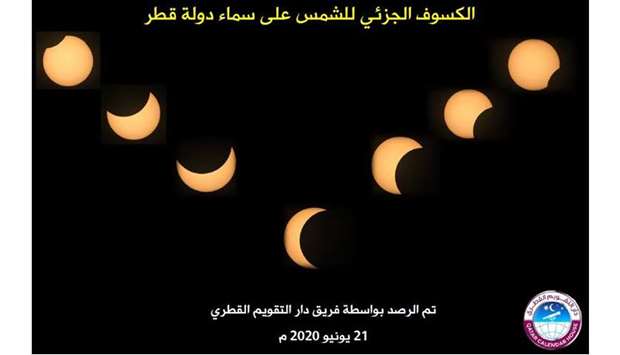Qatar observed a partial solar eclipse yesterday where astronomy experts and photographers got the opportunity to study and capture the rare celestial phenomenon.
Though the weather was hot as the eclipse started around 7am, experts and enthusiasts remained out observing the natural event and photographing the moon covering a part of the sun.
The solar eclipse was seen as a partial eclipse over Qatar’s sky, where it started at 7:13am Doha local time, while its greatest occurred at 8:30am, when moon covered 80% of solar disc at the maximum of the solar eclipse over Qatar’s sky. Finally, the solar eclipse ended in Qatar at 10:01am Doha local time.
Talking to Community, Dr Beshir Marzouk, astronomy expert at Qatar Calendar House, said: “The duration of all solar eclipse phases over the Qatar sky was two hours and forty-eight minutes from the beginning until the end of the eclipse.
“On December 26, 2019, Qatar residents watched an annular solar eclipse, while on October 25, 2022, they will be seeing a next partial solar eclipse.”
Dr Beshir further said: “The solar eclipse’s greatest time occurred with the time of the conjunction of new crescent of Hijric month Dhul-Qa’ da I, 1441 AH. The solar eclipse was seen as annular eclipse in parts of Congo, Ethiopia, South Sudan, Pakistan, India; and China. It was seen as a partial solar eclipse from South-eastern and Middle of Africa, the Middle East, and parts of Asia.”
The expert further said: “Generally, the solar eclipses occur when the moon passes between the sun and the earth so that the sun is fully or partially covered. This can only happen before a new moon phase; when the sun and moon are in conjunction as seen from the earth.
“Further, there are four types of solar eclipse: total, partial, annular, and hybrid. It is always advised not to look to the sun during solar eclipses with the naked eye. People can however use solar eclipse glasses or filters.”
Highlighting the scientific significance of the celestial phenomenon, he said: “As known, solar and lunar eclipses are important phenomena because they validated astronomical calculations; where the solar eclipses happen before the first of Hijric months (before new crescent), a lunar eclipse happens at the middle of Hijric months (at full moon phase).”
It was not only the experts who took keen interest in the natural happening. Folks from all walks of life also witnessed the phenomenon and its light effects on the earth. The most interested were the photographers who wanted to capture different phases of the eclipse that does not take place very often.
Shahin Olakara is an expatriate from Kerala, India and works with a government department. He has the hobby of taking wildlife photos. He, however, took his chance to capture the eclipsed sun in the hot day in Barwa City.
He said: “I chose a place near a mosque as I wanted to capture the partially visible sun in the backdrop of a crescent model installed on the top of the mosque’s tall minaret. I used two ten-stop neutral density filters stacked one over the other with FUJIFILM XT2 camera to capture the eclipse.”
Shahin has recently been capturing the eclipses in Qatar. “I try to capture these happenings because it is a challenge to photograph such events. The solar eclipse that occurred last year was hard to capture as it happened early in the morning as the sun was still in the eastern horizon and light was not very bright. This time it was a bright day and we had enough time to capture different phases. The sun was at 45 degree angle in the horizon when the moon started covering it. Further, the day was bright and the sky was clear.”
All phases of the eclipse shared by Dr Beshir Marzouk.

